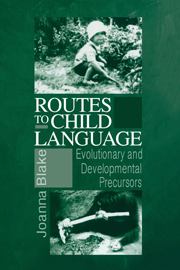Book contents
- Frontmatter
- Contents
- Preface
- 1 Prelinguistic Vocalizations
- 2 Sound–Meaning Correspondences
- 3 Communicative Gestures
- 4 Symbolic Gestures and Symbolic Play
- 5 Tool Use and Object Concept
- 6 Representation in Human Infants
- 7 Memory in Nonhuman Primates and Young Children
- 8 Origins of Language
- 9 Recapitulation
- References
- Index
6 - Representation in Human Infants
Published online by Cambridge University Press: 12 January 2010
- Frontmatter
- Contents
- Preface
- 1 Prelinguistic Vocalizations
- 2 Sound–Meaning Correspondences
- 3 Communicative Gestures
- 4 Symbolic Gestures and Symbolic Play
- 5 Tool Use and Object Concept
- 6 Representation in Human Infants
- 7 Memory in Nonhuman Primates and Young Children
- 8 Origins of Language
- 9 Recapitulation
- References
- Index
Summary
The development of mental representation in infants is controversial first of all for methodological reasons. Piaget's methodology focused on revealing the infant's developing knowledge as functional adaptation, demonstrable in action. He preferred to rely on unambiguous criteria for making inferences about the infant's underlying understanding. For example, intentional, goal-directed behavior was assumed only if the infant removed an obstacle to reach a goal. It is not that Piaget considered intentional behavior to be absent before the age that infants are capable of this action (about 9 months) but that it is not clearly demonstrable. Nativist infant researchers insist that methods requiring such actions on the part of infants preclude the discovery of sophisticated knowledge in very young infants who cannot yet perform the criterial actions. They claim, in fact, that the frontal cortex of young infants may not yet be mature enough to allow the sequencing of two actions, such as the removal of an obstacle to reach a goal (Diamond, 1991). These researchers adopt, instead, passive methods in which very young infants demonstrate their underlying knowledge by preferential looking at one stimulus longer than another. The challenge of this methodology is to design stimulus situations that can elicit looking responses related unambiguously to differences in stimuli.
Evidence from Preferential-Looking Paradigms
Spelke and her associates (Spelke, 1991; Spelke, Breinlinger, Macomber, & Jacobson, 1992) presented a series of situations to very young infants (aged 2 to 4 months) to test their representational knowledge of objects.
- Type
- Chapter
- Information
- Routes to Child LanguageEvolutionary and Developmental Precursors, pp. 171 - 185Publisher: Cambridge University PressPrint publication year: 2000



